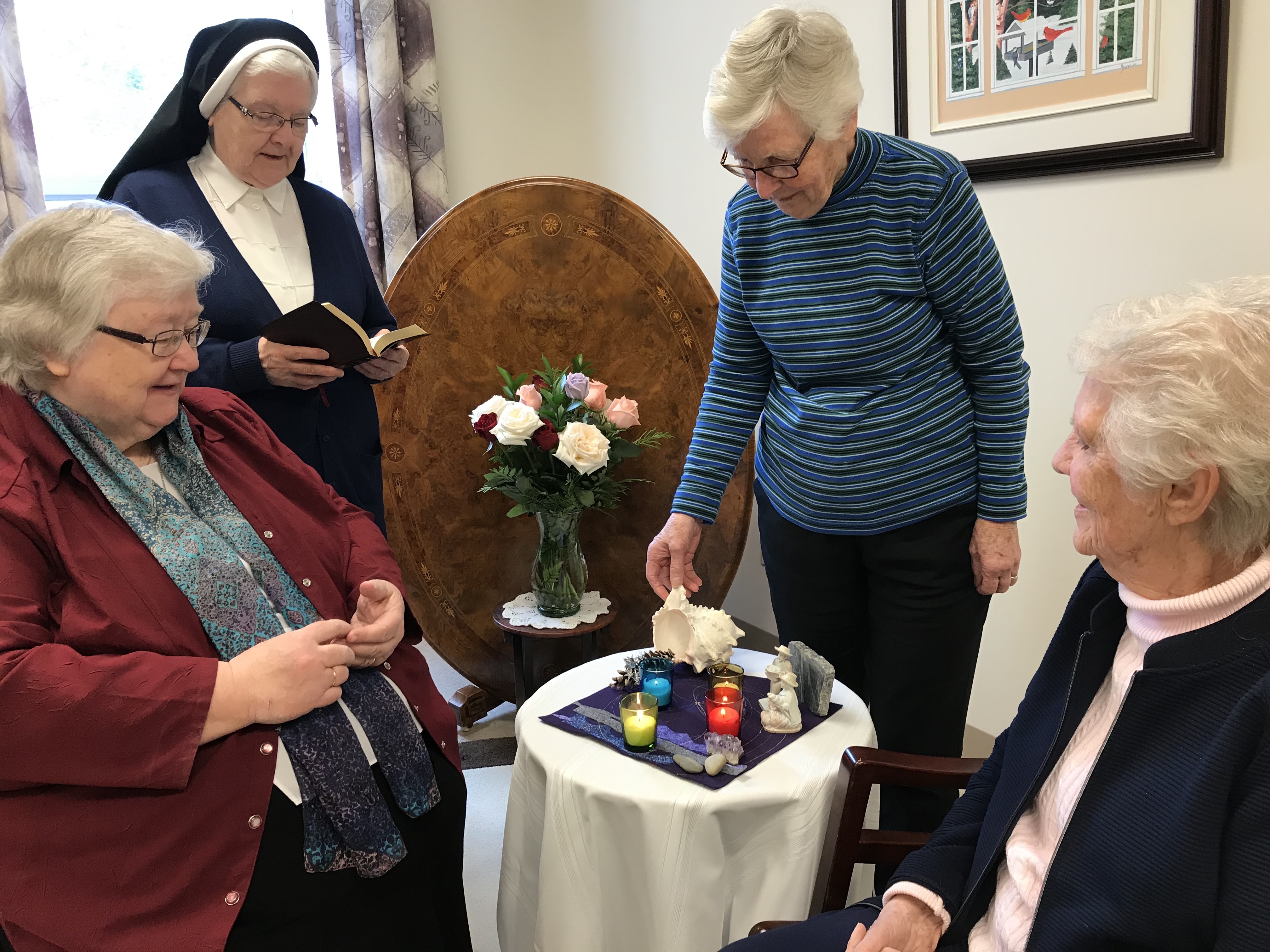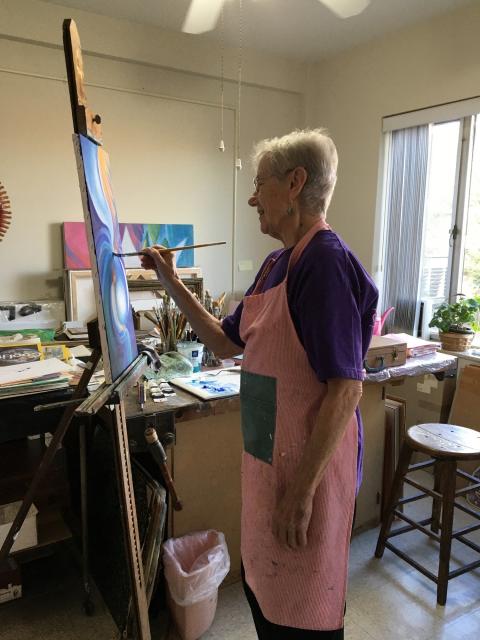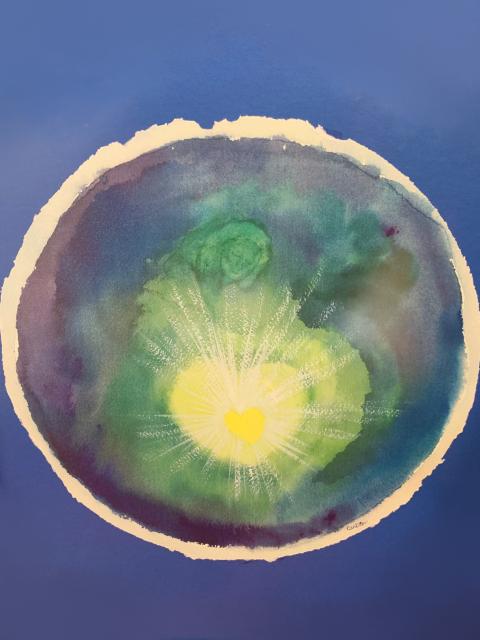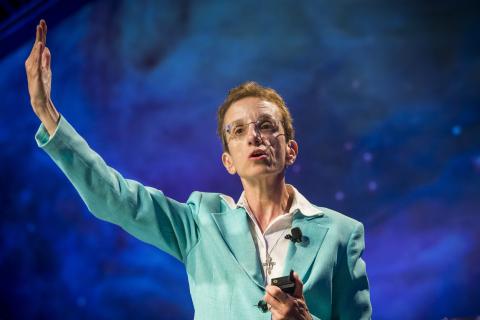
Mercy Sr. Elizabeth Davis, left, participates in the lighting of the cosmic Advent wreath with others in her community, the Sisters of Mercy of Newfoundland. Davis said the large rock is from Labrador (among the most ancient rocks on Earth), the conch and two figurines are from Peru, and the stones and a pine cone from Newfoundland. The wreath was designed by Notre Dame Sr. Joyelle Proot. (Courtesy of Elizabeth Davis)
Each Sunday in Advent, Sr. Elizabeth Davis and her fellow Mercy sisters light a candle on their cosmic Advent wreath adorned with shells, pinecones, rocks and colorful ribbons.
The four candles symbolize the births of, in order: the universe, the solar system, Jesus Christ and, finally, "the birth of each one of us into the whole cosmic body of the universe," said Davis, a member of Mercy International Association.
While Christmas is a celebration of God becoming incarnate through the birth of Jesus Christ, theologians consider God's first act of incarnation to be the birth of the cosmos, inspiring some religious communities to incorporate a cosmic dimension to their seasonal reflections and celebrations. (Davis noted that her community, Sisters of Mercy of Newfoundland, got the idea of a cosmic Advent wreath from the School Sisters of Notre Dame.)
The Mercy sisters are working to democratize the theological language around Christ and the cosmos through Mercy Global Presence, a program that uses art and ordinary language to examine otherwise abstract topics. The online resource for December is themed "Incarnate God in Cosmos and in Person of Jesus."
"What's happening now is quite a fundamental shift for ordinary sisters, men, women and children, that we're starting to understand [the universe] in ways we couldn't have even 10 years ago," said Davis, who serves on the guiding team for Mercy Global Presence and as liaison with the 12 congregational leaders of Sisters of Mercy.
"That's a fundamental shift in our theology, in our spirituality, in how and where we do ministry," she said.
And a shift in how to think about Christmas.
The "singular mystery of Christ"
When modern theologians talk about a "cosmic Christ," Davis said, those without a theological background likely struggle to grasp what that means.
"Writers are now helping us see what Colossians told us from the beginning," she said, quoting Colossians 1:15: "Christ is the image of the invisible God, the firstborn of all creation."
Advertisement
Davis said today's theologians urge people to "read Scripture and realize that God's first way of visibly manifesting was through all of creation."
Roughly 2,000 years ago, "God becomes manifest once again as a visible being, and this time, it's Jesus. Jesus the Christ is, in a sense, two ways of God being very visible among us: the Christ being in all creation, [and Christ] the person being Jesus, who dies and rises."
Sr. Ilia Delio, a member of the Franciscan Sisters of Washington, D.C., who also wrote Making All Things New: Catholicity, Cosmology, Consciousness, said that "God's love made manifest in created reality is the Christ, and that comes to explicit consciousness in the person of Jesus of Nazareth."
"It is true to say that God's life, incarnate in materiality, is present throughout the whole cosmos," said Delio, a columnist for GSR. "But that whole cosmos is recapitulated, so to speak, in the person of Jesus, who has a unit of awareness of God in a way that is singular, unique to him."

St. Joseph Sr. Mary Southard paints "Annunciation" in her Illinois studio. "It's like the Annunciation revealing new levels of meaning to me as I work on this new painting," she said. "It's not the first time I've painted the Annunciation, but there are new insights." (Courtesy of Mary Southard)
Put in even plainer terms: "Jesus is Christ, but Christ is more than Jesus ... It's not a separation," Delio said. "It's a singular mystery."
Jesus Christ is "as if the whole universe becomes one human person."
A cosmic spirituality
As a trained scientist with advanced degrees in biology and pharmacology, Delio said she has always been intrigued by the material world. But her doctoral work at Fordham University led her to St. Bonaventure, a 13th-century Franciscan and "keen observer of the cosmos — like everyone at the time," she said.
The "divorce" between theology and cosmology is "more modern than ancient," said Delio, who is the Josephine C. Connelly Endowed Chair in Theology at Villanova University.
Studying Bonaventure and his contemporaries prompted her to wonder how the medievalists bridged theology and cosmology, "and who will do it today?"
Before exploring these questions, Delio said she had a personalized relationship with God that allowed judgment of others who didn't share her specific beliefs, as she was convinced of "what God would want."
"A narrow God led to a narrow worldview for me," she said. "As my understanding of God began to expand with the cosmos, so, too, I began to become more inclusive of the many ways God could be at work in our world ... I began to lessen my need to control and to have certainty, to live more patiently and entrust in the unknowingness of things."
Davis echoed the sentiment: "Your whole sense of spirituality changes. How you do ministry changes."

One of the pieces of art used in the Mercy Global Presence program: "The Compassionate Heart of the Cosmos," painting by Sr. Corlita Bonnarens, of the Sisters of Mercy of the Americas. (Courtesy of Mercy International Association)
The "wonder and awe," Davis said, led to a "much deeper awareness of how connected all of us are."
Delio said for her, the important question is not whether one believes in God, "but what kind of God do we believe in?"
Tying together the scope of the cosmos with the power of God inspired her to live a more contemplative prayer life, abandoning the structure that organized prayers in minutes and hours and instead embracing an "informal being with God in a prayerful way," she said, akin to how St. Francis of Assisi "became himself a living prayer."
Understanding through art
St. Joseph Sr. Mary Southard is an artist whose subjects, whether portrayed in a painting or a sculpture, often depict God and the cosmos. The way she sees it, "the first artist is God."
The "unfolding of universe as we know it is really God's self-expression — that's the artist point of view — creating all this amazing beauty and lives and forms and interactions and the inner and outer world, woven so beautifully together."
After Southard found other sisters who were interested in a cosmic spirituality, they started a group in 1994 called Sisters of Earth, an informal network with a focus on ecology and spirituality.
The "immensity and magnificence of the universe" is a relatively recent discovery, Southard said, thus shifting collective images of God. The "old story," communicated through the Old Testament, provides images of an "all-powerful, somewhat separate God, reaching into human lives," Southard said.
But images of God emerging today — the "new story" — differ from the original, as science reveals the vastness of space and time and the intricacies of matter and spirit.
"The power of image is so important in order to help us make this transition into seeing the Earth as sacred with sacred eyes. Until we do that, we'll keep wrecking the planet," Southard said.
"There's a huge need right now to recognize that we're nourished in both body and soul by everything and everyone around us," she said, emphasizing "the power of the images we carry of the universe, of ourselves, of God, and how they're intimately related to one another."
Creating a global Mercy presence
Bringing these heady topics down to Earth is one reason Mercy sisters launched Mercy Global Presence, an online resource that will capture the spirit of Delio's plainspoken cosmic theology and Southard's artistic portrayal of the cosmos.
Throughout the 2015-2016 Year of Mercy, Mercy International engaged in a reflection process with coordinators from each of the 12 congregations, gathering 250 groups of sisters and laypeople to discuss "what mercy should be in the 21st century," Davis said, essentially offering "an antidote" to the globalization of power and greed today.
The result was Mercy Global Presence: four online segments, each lasting four months and with a new theme guiding that month based on the segment's overarching concept, that bring together "global perspectives, theological imaginings, an artistic response, and a distinctive voice that could be from anywhere," said Anne Walsh, communications director for Mercy International.
Each month presents the work of a theologian and an artist who are free to examine and interpret that month's theme as they please. Posted online the last Wednesday of the month, the resource includes a facilitator's guide so participants can discuss in small organized groups or reflect on their own.
"Any time two or three people are gathered and reflecting on this, we're adding to mercy and justice globally," Davis said. "The very experience of that makes the world a better place."
The program, open to anybody, launched in September. The first four-month segment explores the global, a concept that goes far beyond the international, Davis said. (The second segment focuses on mercy; the third segment, the present; the fourth segment, tying together all three.)
September focused on cosmology and how God "mercified the universe into being," Davis said, borrowing a phrase from Islamic spiritual master Ibn Arabi. A welcome coincidence, October centered on Earth and ecology just as the synod on the Amazon addressed the region's environmental concerns and established ecological sin and as 16-year-old Greta Thunberg took her environmental activism to the United Nations. November's lesson plan looked at the social shifts sweeping the day, such as radical fundamentalism or same-sex parenting.
The fourth dimension of the global segment, made available Dec. 18, is "our new sense of incarnation," Davis said.
"Incarnation has always focused on the person of Jesus, and that important focus remains, but we're reminded more clearly back to cosmos."
A self-communicative God for Christmas
In her 2018 Christmas painting, Southard depicted God holding Earth in his hands, a mini Bethlehem with Mary, Joseph and Jesus at its heart. But the cosmos is there, too.

Franciscan Sister Ilia Delio (CNS photo/Roberto Gonzalez)
"The whole universe is the first incarnation, God's initial self-outpouring," she said. "Then we have God's specific self-outpouring in Jesus, but not just in Jesus — in all of us."
God, Delio said, helps reorient and allow people to escape a "narrow individualism and anthropocentrism where it's all about me," a reminder that each person is a part of something greater.
"God and religion may be the most important aspect of our world that we need to reclaim today," Delio said. "We cannot have theological language that's only technical ... that belongs to an elite. It has to be language that speaks to people.
"Theology is God-talk," she said, which should be "able to talk about God to other people and make this mystery of God accessible in everyday life so we can share a ground of meaning together. It's a point of unity if we can make it accessible and bring it to life."
For Delio, the gift-giving aspect of the Christmas season, though a byproduct of modern consumerism, still has an interesting connection to the larger cosmic picture: Giving gifts "symbolizes our deep intrinsic relationality."
That people love giving gifts is "so interesting to me because our deep relationality and our desire to celebrate life together speaks to the type of world we live in, which is a deeply relational, interconnected universe ... grounded in a deeply relational God."
Only a relational, self-communicative God can be an incarnate God, Delio said.
"There's something beautiful in reflecting on that babe in the manger, helpless, vulnerable, weak, and to reflect that a God who gives God's self entirely to us in vulnerability, in weakness, in hiddenness, a God bending low in love to be God with us, in us, for us."
[Soli Salgado is a staff writer for Global Sisters Report. Her email address is ssalgado@ncronline.org. Follow her on Twitter: @soli_salgado.]







